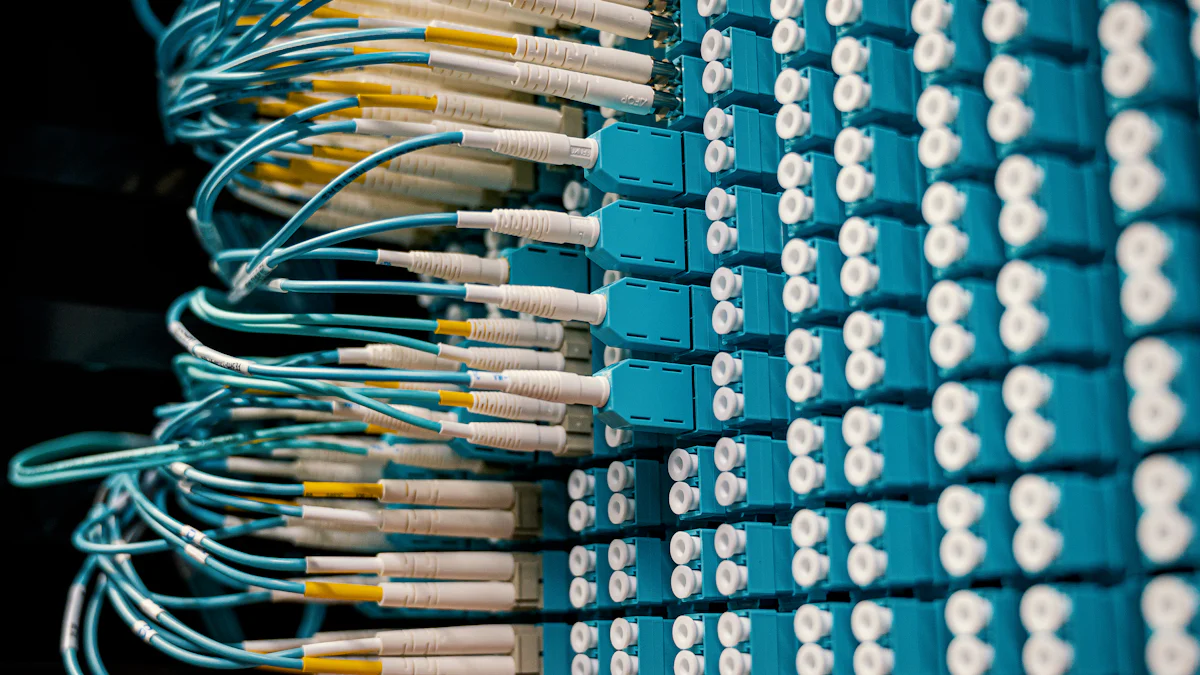Bridging Continents: An In-depth Look at U.S. and Chinese Supply Chain Operations

Supply chains play a crucial role in the global economy. They ensure the smooth flow of goods from producers to consumers. The United States and China hold significant positions within these networks. China stands as the world's largest exporter, while the United States remains a major importer. This blog aims to compare and analyze the supply chains of these two economic giants.
Structure of Supply Chains
United States Supply Chain Structure
Key Components
The United States supply chain structure relies heavily on advanced technology and high-value manufacturing. Key components include electronics, automotive parts, pharmaceuticals, and aerospace products. The integration of cutting-edge technology ensures efficiency and productivity. The focus remains on maintaining a robust and resilient supply chain.
Major Industries
Several major industries drive the US supply chain. The technology sector leads with giants like Apple and Microsoft. The automotive industry, represented by companies like Ford and General Motors, plays a crucial role. Pharmaceuticals, with firms such as Pfizer and Johnson & Johnson, contribute significantly. Aerospace, dominated by Boeing, also forms a vital part of the supply chain.
Regional Distribution
The regional distribution of the US supply chain shows significant concentration in certain areas. The West Coast, particularly California, serves as a hub for technology and innovation. The Midwest, known as the "Rust Belt," focuses on automotive and manufacturing industries. The East Coast, including states like New York and Massachusetts, excels in finance and pharmaceuticals.
China Supply Chain Structure
Key Components
China's supply chain structure emphasizes innovation and technological development. Key components include electronics, textiles, machinery, and chemicals. The focus on high-value manufacturing enhances supply chain resilience. The Belt and Road Initiative has further strengthened China's supply chain by building alternative routes.
Major Industries
Several major industries dominate China's supply chain. Electronics, led by companies like Huawei and Xiaomi, play a significant role. The textile industry, with numerous factories producing garments for global brands, remains crucial. Machinery and equipment manufacturing, represented by firms like Sany and Zoomlion, contribute heavily. The chemical industry also forms a vital part of China's supply chain.
Regional Distribution
The regional distribution of China's supply chain shows a diverse landscape. The coastal regions, including Guangdong and Shanghai, serve as major manufacturing hubs. The inland provinces, such as Sichuan and Hunan, focus on heavy industries and resource extraction. The northern regions, including Beijing and Tianjin, excel in technology and innovation.
Comparative Analysis
Similarities
Both the United States and China have advanced supply chains that rely on technology and innovation. High-value manufacturing plays a crucial role in both countries. Both nations focus on maintaining resilience and efficiency within their supply chains. Major industries, such as electronics and machinery, dominate the supply chains in both countries.
Differences
Key differences exist between the supply chains of the United States and China. The US is moving towards friendshoring or nearshoring to reduce direct trading with China. However, the US still depends on China indirectly. China's supply chain system focuses more on innovation and technological development. The Belt and Road Initiative has enabled China to build alternative supply chains, reducing dependence on traditional routes.
Efficiency and Performance
United States Efficiency Metrics
Productivity
The United States boasts high productivity levels in its supply chains. Advanced technology and automation drive this efficiency. Companies like Amazon and Tesla exemplify this productivity. These firms leverage cutting-edge tools to streamline operations.
Cost Management
Cost management in the US supply chains focuses on reducing overheads. Businesses adopt lean manufacturing principles. This approach minimizes waste and maximizes resources. Walmart's supply chain strategy highlights effective cost management. The company uses data analytics to optimize inventory and reduce costs.
Time Management
Time management remains crucial for US supply chains. Firms prioritize quick turnaround times. Efficient logistics networks support this goal. FedEx and UPS lead in time management. These companies ensure timely deliveries through advanced tracking systems.
China Efficiency Metrics
Productivity
China's supply chains emphasize high productivity. The "Made in China 2025" plan underscores this focus. Innovation and technological development boost productivity. Companies like Alibaba and BYD showcase China's efficiency. These firms integrate new technologies to enhance output.
Cost Management
Cost management in China involves strategic investments. The Belt and Road Initiative plays a key role. This initiative builds alternative supply routes. It reduces dependency on traditional paths. Chinese firms also benefit from lower labor costs. This advantage helps maintain competitive pricing.
Time Management
China excels in time management within its supply chains. Efficient manufacturing processes contribute to this strength. Rapid production cycles characterize Chinese factories. Companies like Huawei and Lenovo demonstrate this efficiency. These firms ensure swift product delivery to global markets.
Comparative Analysis
Strengths
Both countries exhibit unique strengths in their supply chains. The US excels in technological integration. Advanced tools enhance productivity and efficiency. China leverages cost advantages and strategic initiatives. The Belt and Road Initiative strengthens China's supply chain resilience.
Weaknesses
However, each country faces distinct challenges. The US grapples with higher labor costs. This factor impacts overall cost management. China depends heavily on foreign investment and technology. The COVID-19 pandemic disrupted China's supply chains. This disruption highlighted vulnerabilities in global dependencies.
Technology and Innovation

Technological Advancements in the United States
Automation
Automation plays a crucial role in the United States supply chains. Companies like Tesla use robots to assemble cars. This technology reduces human error and speeds up production. Factories with automation can produce goods faster and more efficiently.
Data Analytics
Data analytics helps companies make informed decisions. Walmart uses data to manage inventory and predict customer demand. Data analytics improves supply chains by identifying trends and optimizing resources. Businesses can reduce waste and increase profits with accurate data.
Blockchain
Blockchain technology ensures transparency and security in supply chains. IBM uses blockchain to track food products from farm to table. This technology prevents fraud and ensures product authenticity. Blockchain creates trust between suppliers and consumers.
Technological Advancements in China
Automation
China invests heavily in automation for its supply chains. Companies like BYD use automated systems to manufacture electric vehicles. Automation increases productivity and reduces labor costs. Chinese factories can produce large quantities of goods quickly.
Data Analytics
Data analytics drives efficiency in China's supply chains. Alibaba uses data to enhance logistics and delivery services. Data helps companies understand market trends and customer preferences. Efficient data use leads to better decision-making and resource management.
Blockchain
Blockchain technology gains traction in China's supply chains. Tencent uses blockchain to verify the authenticity of luxury goods. This technology combats counterfeit products and ensures quality. Blockchain enhances trust and transparency in transactions.
Comparative Analysis
Adoption Rates
The United States adopts new technologies at a rapid pace. Companies invest in automation, data analytics, and blockchain to stay competitive. China also embraces these technologies but focuses more on large-scale implementation. Both countries recognize the importance of innovation in supply chains.
Impact on Efficiency
Technological advancements improve efficiency in both countries. Automation reduces production time and errors. Data analytics optimizes inventory and predicts trends. Blockchain ensures transparency and security. These technologies make supply chains more resilient and reliable.
Challenges and Opportunities

Challenges in the United States
Regulatory Issues
The United States faces complex regulatory issues in supply chains. Government regulations often change, creating uncertainty for businesses. Compliance with these regulations requires significant resources. Companies must navigate federal, state, and local laws. These regulations impact various industries differently.
Labor Shortages
Labor shortages pose a significant challenge for US supply chains. The aging workforce contributes to this issue. Younger workers often lack the necessary skills. Companies struggle to find qualified employees. This shortage affects productivity and efficiency.
Environmental Concerns
Environmental concerns also impact US supply chains. Companies face pressure to reduce carbon footprints. Regulations require businesses to adopt sustainable practices. This shift increases operational costs. Companies must balance environmental goals with profitability.
Challenges in China
Regulatory Issues
China's regulatory landscape presents challenges for supply chains. The government frequently updates policies. Companies must stay informed about these changes. Compliance requires substantial effort and resources. Regulatory uncertainty affects business planning.
Environmental Concerns
Environmental concerns pose challenges for China's supply chains. The government enforces strict environmental regulations. Companies must invest in green technologies. Compliance increases operational costs. Balancing growth with sustainability remains a challenge.
Opportunities for Improvement
Innovation
Innovation offers opportunities for improving supply chains. Companies can adopt new technologies to enhance efficiency. Automation reduces reliance on manual labor. Data analytics provides insights for better decision-making. Blockchain ensures transparency and security.
Collaboration
Collaboration between stakeholders can strengthen supply chains. Businesses can partner with academic institutions for research. Governments can support industry initiatives. International cooperation can address global challenges. Collaborative efforts lead to more resilient supply chains.
Policy Reforms
Policy reforms can create favorable conditions for supply chains. Governments can simplify regulations to reduce compliance burdens. Incentives can encourage sustainable practices. Trade policies can promote international cooperation. Reforms can enhance supply chain resilience and efficiency.
The comparison of supply chains between the United States and China reveals distinct strengths and weaknesses. The US excels in technological integration and productivity, while China leverages cost advantages and strategic initiatives like the Belt and Road Initiative. Businesses must adapt to these dynamics by investing in innovation and collaboration. Policymakers should focus on simplifying regulations and encouraging sustainable practices. Future improvements in supply chains will hinge on resilience and diversification strategies. The evolving landscape of global supply chains demands continuous adaptation and proactive risk management.
See Also
Exploring the Impact of Global Consumer Demands on Supply Chains
The Significance of Supply Chains in Global Trade
The Revolution of Supply Chains through Robotics Innovation
